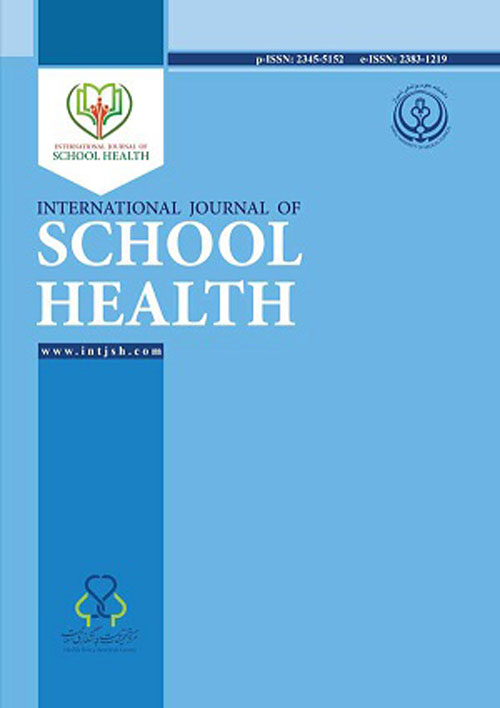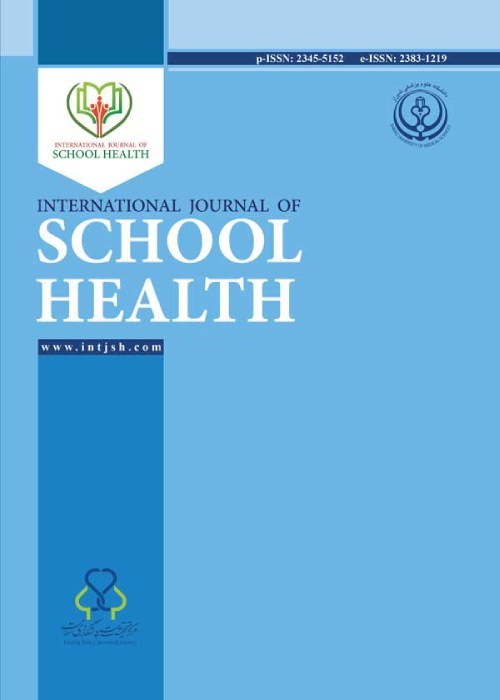فهرست مطالب

International Journal of School Health
Volume:2 Issue: 1, Winter 2015
- تاریخ انتشار: 1394/01/18
- تعداد عناوین: 7
-
-
Page 1BackgroundFeedback is one of the most important variables which affect the motor acquisition and the performance of a skill which plays a significant role in motor control as well as the learning of a motor skill..ObjectivesThe present study serves to assess the acquisition and retention of a new motor skill in pre-elementary school students, while presenting them with an additional feedback with different frequencies (0%, 50%, and 100%)..Patients andMethodsThe methodology of the current study is Semi-experimental, with pretests and posttests conducted on children presented with three different frequencies of additional knowledge of results (KR) feedback (0%, 50%, and 100%). The statistical population consisted of all 6-8 year old pre-elementary school students of Ahvaz, of whom 45 were selected through multilevel cluster sampling, and were subsequently divided, in three different groups. The selected task for the subjects consisted of throwing a tennis ball from over the shoulder toward a target depicted on the ground. The subjects performed 60 try-outs within the acquisition phase, in which the 0% group was presented with no feedback at all, 50% group received feedback in 50% of the try-outs, and 100% group obtained feedback in all try-outs. Three days after the acquisition phase, retention tests with 10 throws were conducted. One Way Analysis of Variance (ANOVA), Tukey test, and repeated measures test were used on each block for data analysis..ResultsThe results indicated significant differences between all three groups, both within the acquisition and retention tests (P = 0.001). The findings were suggestive that the 100% group performance was significantly superior to the other two groups in the acquisition phase, while the 50% group was significantly superior within the retention phase..ConclusionsIn short, it can be concluded that children might benefit more from the reduced feedback for learning a skill..Keywords: Learning, Children, Feedb
-
Page 2BackgroundAutism spectrum disorder (ASD) is a developmental and neurological disorder that impairers many processes as perceptual, motor and cognitive function. Feedback frequency and its influences on ASD aspects indicate conflict impairs..ObjectivesThe aim of the current study was to investigate the frequency of feedback in children with autism and comparison with normal children during learning a new throwing task..Patients andMethodsIn this study, 21 children with autism and 21 normal children were selected and each group was randomly divided into three subgroups (receiving 0%, 50%, 100% feedback). Participant’s task was throwing beanbags toward the goal. In the acquisition phase, each participant performed 60 throws. Experimentally, group (0%) did not receive any feedback, group (50%) received feedback in half efforts and group (100%) received feedback in all the efforts. The retention test was performed 24 hours after the acquisition phase. One-way analysis of variance and Tukey post hoc test were used to analyze data..ResultsChildren with autism showed more learning by 100% feedback. Nonetheless, normal children learned more through reduced feedback (50%)..ConclusionsIn learning a new task, children with autism bring more performance in high frequency of feedback, but normal children showed better performance using reduced feedback. This finding indicates that children with autism need to get feedback different from normal children in learning..Keywords: Learning, Autism, Feedback, Children
-
Page 3BackgroundAddiction is a serious social problem that can effect on the future of the youth as the most valuable asset for every nation. It threatens not only the lives of millions of people of the world, but also ruins many social values and norms. The best way to confront with addiction is prevention and teenagers should be educated about complications of drugs by the experts and researchers at their schools..ObjectivesThe aim of this study was to determine the knowledge and attitudes of male high-school students of the harms of Addiction in Urmia, Iran..Patients andMethodsThis is a cross sectional study in which, 306 male students from high schools in Urmia city were selected based on simple sampling by using a demographic and researcher-designed questionnaire. The validity of the questionnaire both in terms of content and appearance was verified by the board members of the Urmia University of Medical Sciences, and the reliability with the internal compatibility index..ResultsMost of the samples stated that they told their parents about their new friends, as an indication of the families'' control on them and believed that curiosity is an important factor in addiction, and declared that media''s depiction of the harms of addiction has biased them against drug use. Also, it was obvious that the samples'' demographic characteristics, including age, neighborhood, previous grade average, number of siblings and parents'' education, did not have a significant correlation with their knowledge of and attitude to addiction (P > 0.05)..ConclusionsBased on the results, it is recommended to enhance students'' knowledge; about factors that may encouraged them to be addicted; and educational programs in the media be reinforced. In addition, the authorities should support the youth by screening programs and the establishment of counseling settlements for identify and eliminating the contributory factors to drug addiction..Keywords: Knowledge, Attitude, Students, Addictive Behavior, Iran
-
Page 4BackgroundImproving health-related behaviors maintain function and independence and improve the quality of life and reduce health care costs. The characteristics of puberty in girls, their physical and mental conditions during this period, and also their essential role in fertility underline the great importance of health care in adolescent girls..ObjectivesThe aim of this study is to determine the health-promoting behaviors in high school students in district 2 of Isfahan..Patients andMethodsThis descriptive study was conducted on 500 high school girl students selected by multi-stage random sampling in district 2 of Isfahan. The data collection was based on standard questionnaire of health promoting behaviors (HPLPII), filled by the participants which was analyzed using descriptive and inferential statistics by SPSS win/11..ResultsThe findings of this study indicated that the total mean score of health promoting behaviors in students was 71.2 ± 21. The highest score gained by the studied population was related to the spiritual growth (19.7 ± 6.1) and the lowest score to physical activity (6.1 ± 4.7)..ConclusionsConsidering adolescence period as a foundation for the future life and society''s health, providing appropriate hygienic, consultation and educational services to adolescents and their families should be emphasized and included in the hygienic schedules of schools..Keywords: Health, Behaviors, School
-
Page 5BackgroundAggression in childhood is the predictor of delinquency, depression, school dropout, and drug abuse in higher ages. The preschool year is an appropriate time to diagnose children’s problems and plan for interventions to prevent their emotional, social, and educational problems..ObjectivesThe present study determines the types of aggression among kindergarten and preschool children..Patients andMethodsA total of 14 kindergarten and preschool centers were chosen using random cluster sampling in Mohr County 2013. The inclusion criteria were level of aggression higher than 125.77 for boys and 117.48 for girls based on the preschooler aggression inventory. In this regard, 60 kindergarten and preschool children were enrolled in this study..ResultsThe results showed that 33.45%, 31.15%, 22.29%, and 13.11% of the children had verbal aggression, physical aggression, relational aggression, and impulsive anger, respectively. In addition, the verbal aggression and physical aggression scores of the boys were higher than for girls. However, no significant differences were found between the genders concerning relational aggression and impulsive anger. Moreover, the highest level of aggression was observed among 6 years old children followed by 5-, 3-, and 4-years old children..ConclusionsConsidering the high rate of verbal and physical aggression and the negative effects of aggression on educational and social behavior, early intervention is recommended for prevention and treatment..Keywords: Aggression, Child, Adolescent, Health, Mental Health
-
Page 6BackgroundGetting enough calcium in growing is necessary to achieve peak bone mass and to prevent osteoporosis in adulthood and aging..ObjectivesGiven the importance of women''s role in arranging and preparing the family food basket, the present study aimed to raise the mothers'' knowledge and attitude to increase consumption of calcium-rich foods in family food basket and enhance adolescent girl’s performance in the city of Chabahar..Patients andMethodsThis experimental study was performed on mothers of female students in the fifth grade of primary school in selected primary schools of Chabahar city during 2014. The population under study was selected by random sampling multi-stage stratified method. The study comprised 170 eligible mothers including 88 controls and 82 tests, selected on voluntary basis, who provided their written informed consent to participate in the study. Data collection tool was validated and reliable self-administered questionnaire consisting of three sections. These included demographic information and questions related KAP (knowledge, attitudes and practice) model comprising three structures so called knowledge, attitude and practice related to calcium containing foods. The completion of questionnaire was based on self-report and interview in two stages by the researcher, before and three months after educational intervention. The data collected were analyzed by SPSS-16 using descriptive and analytical statistical tests such as paired T-test at α = 0.05..ResultsA statistically significant mean score of knowledge and attitude was found after intervention in case group. However, the changes in mean score performance variables after the intervention in the case group were not significant..ConclusionsDesigned and implemented educational intervention was effective in increasing the mother’s knowledge and attitude, but was not effective regarding the intake of calcium-rich foods in target group. This weakness can be attributed primarily to the content and type of intervention carried out and secondly to insufficient educational interventions and sample size compatible with acceptable performance that suggested conducting more effective educational and ecological interventions..Keywords: Education, Calcium, Mother, Student
-
Page 7BackgroundSpoken and written language skills of prelingually deaf pupils should be evaluated to improve the existing language curricula..ObjectivesThe current study aimed to determine the oral language development of the students with hearing impairment studying in Shiraz special primary schools..Patients andMethodsThe current research was administered as a cross-sectional study. The sample size was 29 Farsi language students of exceptional primary schools with hearing impairment in Shiraz, Iran. A speech-language pathologist (SLP) evaluated the subjects by Farsi version of the Test of Language Development-Primary 3 (TOLD-P: 3) individually. A number of TOLD-P: 3 subtests were administered in the subjects including: semantics, grammar, listening, organizing, speaking, and overall language ability. To determine the oral language ability of the subjects compared to the norms, the subjects’ score in each dimension was statistically compared with the nearest category in the scale. The data were registered in IBM SPSS 21, and analyzed by means of one-sample T-test at 0.05 significance level..ResultsThere was a significant difference between the subject’s scores in all sub-tests and the category of moderate in TOLD-P: 3 (P < 0.001)..ConclusionsBased on the current study, the students with hearing impairment enrolled in special schools had difficulties to learn optimal oral language skills compared to their normal peers..Keywords: Hearing Loss, Pupils, Special Schools


